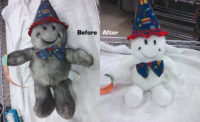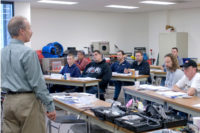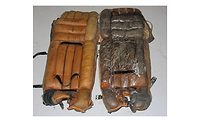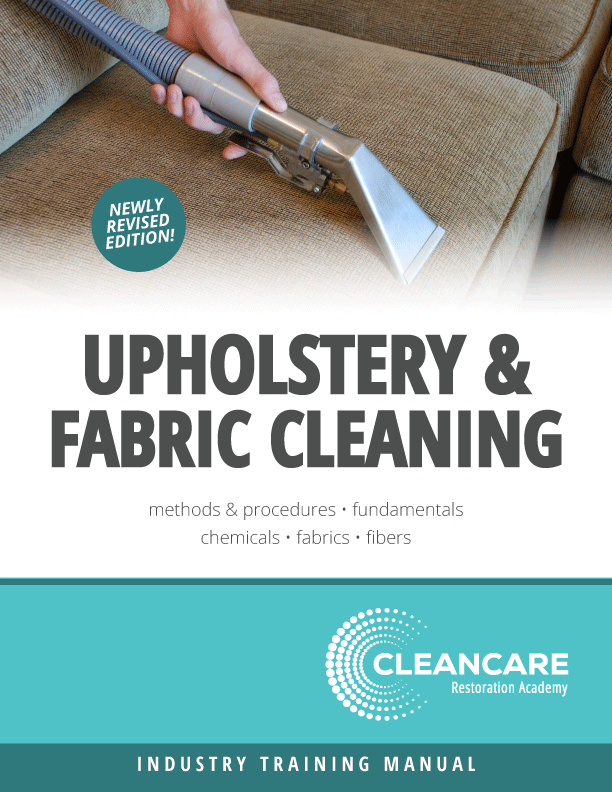From Textiles to Hard Goods: Contents Restoration Categories and Cleaning Methods
A look at four different types of contents restoration












A textile expert represents the cleaning and restoration of about 23 percent of the contents in a home – the largest single category of items.
That’s according to Wayne Wudyka, CEO, Certified Restoration Drycleaning Network (CRDN).
There’s leather, suede, fur, shoes, hats, bedding, window treatments, rugs, launderable items and dry cleanable clothes that all help make up this category of contents restoration.
Textile and garment restoration has been CRDN’s specialty since its inception in 2001. Today, the originators of the textile restoration category service over 20,000 claims per year across North America – at a 98% success rate. The average savings on these items after a home fire or other disaster is about 80% of the cost or replacement.
“That’s a tremendous savings when you look at what we do,” Wudyka says. “The cost of cleaning items comes to about 20% of the replacement cost of a typical family’s wardrobe.”
Once a textile expert is called to a scene, Wudyka says that a typical work order can be turned around within two to four business days. Here’s a look at the process of garment and textile restoration:
Step 1: A textile expert will arrive on-scene and ask the homeowner to put together two weeks worth of clothes for themselves and their family, which are then immediately taken and turned around within a 24 hour span. “That reduces the additional living expense, so the homeowner doesn’t have to spend the time or the money to go out and buy temporary clothing,” says Wudyka.
Step 2: Taking a detailed inventory is the next step. “We want to make sure we write down and photograph the contents,” Wudyka says. “We take a lot of digital photos of the home, every room – so we know how the drapes are hanging on the wall, where the rugs were, etc. We want to detail that, so the homeowner knows what we’re taking, especially when you get into expensive and sentimental items like wedding gowns.”
Step 3: The contents are then removed from the home and taken back to a storage facility where they’re then sorted and cleaned. Speed to cleaning is important due to oxidation and the setting of stains. For instance, in a water loss it’s important to dry the clothes as quickly as possible, as items might bleed and fabrics may degrade. In a fire loss, hydrocarbon can pit out various types of fabric.
Step 4: Cleaning: Wudyka estimates that 60% of the textiles and garments coming out of the home will get wet-cleaned or laundered. “In the drycleaning process, there are a couple of different solvents that are principally used,” he says. “The most important thing, regardless of the solvent you’re using, is that you use a two-bath dissolution system, because we’re dealing with a higher level of contaminant than a corner drycleaner does. A textile restoration company is salvaging items that have been exposed to extreme conditions like smoke, fire, water, mold (and) mildew.”
Step 5: Return to homeowner: After the textiles and garments are restored, the last step is returning it to the homeowner. For CRDN, this includes rolling the rugs out, hanging the drapes back up and even repacking the drawers and dressers.
ELECTRONICS
There’s TV sets, projectors, DVD and Blu-Ray players, remote controls, computers, cell phones, clocks, video game consoles, printers, cameras, scanners, fans and dehumidifiers.
The list of electronics that are found in the home goes on and on and on…
The Consumer Electronics Association estimates that the average American household has about 24 electronic gadgets and spends over $1,300 annually on such items. Now just imagine how many of them could be damaged in a water loss or fire – one could be out thousands of dollars, not to mention devices they’ve come to rely on for everyday tasks.
That’s where electronics restoration comes into play, specifically with aqueous stations and drying chambers, which yield a near 100% success rate.
It’s All in the WaterOzone washing has been around for many years. However, now it’s been taken to a whole new level regarding textile and garment cleaning and restoration thanks to a patented process of smoke stain and odor removal. It consists of three core parts: Ozonated Water: There are several methods to ozonate water. Combining a gas (ozone) with a liquid (water) is not a natural process. For this to be effective, a very pure form of ozone is injected into the water under a vacuum. This increases the mass transfer rate of the ozone and bonds the water and ozone at a molecular level. This keeps the ozone in the water for greater effectiveness. Temperature: Water temperature is also important to the ozone. Ozone is unstable and is always converting back to its natural state of oxygen. At warmer temperatures, the ozone will degrade quicker than at lower temperatures. This gives less contact time with the soiled garments. Chemistry: Special additives are designed to work on a certain soil classification (carbon-based soil) in cool water temperatures that will complement the ozonated water. Most detergents work best at 120°F to 140°F – but the process is able to work in 55°F water temperature. Ozone can oxidize and break down many surfactants used in cleaning today. This process is ideal for cleaning, deodorizing and delivery of smoke-damaged textiles within 24 hours - on every loss - regardless of the severity of the odor. It also enhances the cleaning. No other cleaning process can achieve these results. -Michael Rusciolelli, President/CEO, Evans Garment Restoration |
“The equipment will safely clean basically all electronics,” says John Koniarczyk, of Odell Electronics Cleaning Stations. “There’s nothing out there that can’t really be cleaned with our system. The list is endless.”
Odell originally began 1948, specifically as a company that cleaned out the dirt and dust that built up over time in military applications. In 1992, it segued into the restoration industry to treat water-logged and smoke-damaged items.
The aqueous stations work by deionizing and taking any minerals out of tap water. Doing so removes water’s electrical charge and makes the water safe for electronics cleaning.
“We heat it to about 120°, mix it with a special detergent that’s made for electronics and we push that out with about 50 pounds of air pressure through a special cleaning wand,” Koniarczyk says. “I call it a ‘glorified car wash.’
“Once you spray it down with the solution, you rinse it with the deionized water and it will come out looking like brand new.”
After items are washed, they’re dried in a drying chamber, which also removes any odors from the item.
The process is quick – Koniarczyk estimates that an average computer takes about 10 minutes to clean. Which is good because, after all, there’s bound to be a whole slew of electronics that need to be restored in a catastrophe.
There are microwave ovens, hair dryers, clothing irons and the list goes on and on and on…
HARD CONTENTS
What would you rather do to salvage hard contents after a fire – throw them away, hand clean them or have them cleaned and restored to pre-loss condition within minutes?
If you selected the latter option for your hard contents, then you’ll likely be completing the process with an ultrasonic cleaning system, as the chemicals and water that are used in such equipment are able to penetrate deep into every crevice and crack to lift away soot, dirt, grease, nicotine and more on items ranging from ceiling fans to dishes to figurines to sports equipment and musical instruments.
“The results are outstanding,” says Lisa Morantz, President, Morantz Ultrasonics. “Many of the items that would have previously been considered a loss can now be restored.”
Ultrasonic cleaners utilize millions of microscopic bubbles to dislodge dirt from the application. The ultrasonic machine’s transducers then vibrate, creating sound waves that cause these millions of bubbles to implode repeatedly all over the cleaning tank.
“The constant formation and collapsing of bubbles cause a few things to happen – tremendous heat and pressure at the core of the bubble’s collapse, a vacuum from the bubble’s collapse and a jet stream of water that flows through the vacuum,” says Morantz. “All of this is simply known as ‘cavitation’ and this is what causes dirt to be removed from even the smallest of crevices.”
Ultrasonic cleaning is able to reduce what would be about 30 minutes of hand scrubbing to seconds. In fact, Morantz estimates that up to 100 boxes of contents can be processed with the technology in one day, streamlining the contents restoration process while reducing labor and chemical costs.
What’s more is that the technology continues to improve. In 2000, Morantz Ultrasonics introduced digital equipment to the industry, which can eradicate bacteria and viruses – making ultrasonics applicable for things like cleaning hospital equipment and restoring Category 3 water losses to pre-loss condition.
ART
Founded in 1983, The Conservation Center (Chicago, IL) is one of the country’s largest private art restoration and conservation laboratories. In its 30 years of business, it has treated masterpieces by famed artists, as well as many other artwork from private collections and museums. Currently, the Center is handling over 300 accounts and some 5,000 pieces are moving through its system.
For a closer look at the art restoration process, we chatted with Heather Becker, CEO, The Conservation Center. Here’s what she had to say about the typical job, the process and more:
R&R: When people think of “contents restoration,” I’d imagine art doesn’t immediately come to mind. How much of a demand is there for art restoration services?
Heather Becker: While art restoration may not necessarily be at top of mind, when confronted by disaster in one’s home, homeowners tend to turn to those items that are most precious. It is during such a confrontation that one assesses what is truly meaningful and important to them; this is when we can offer our services to help our clients preserve those items that they value most.
R&R: Can you walk me through a typical art restoration job? Talk about some of the pieces you’ve been asked to restore, the process, the time frame and what the success rate is?
HB: The Center receives projects ranging from small numbers of sentimental family heirlooms to hundreds of items from corporate collections and institutions. The first stage of art restoration is the examination process - our conservators assess the condition of the piece or pieces and outline the appropriate treatment. A proposal describing the condition and proposed treatment, with the associated costs and time, is then drawn up for the client to sign and approve. Following approval of the proposed treatment, the conservators begin their work. As a conservation company, we take every measure to honor an artist’s original intent and characteristics - all of the techniques implemented and materials used are of conservation standards and quality.
The pieces we treat include fine art from some of the country’s most prestigious museums, galleries, insurance companies, corporations and private collections, but our work is not an elite service. The long-standing core of The Center’s work focuses on items from the average American home. Typical projects involve both treating general age and wear to personal items, and treating large fire and water claims. Depending on the project, the time frame for treatment ranges from a few weeks to several months. Our success rate is very high, as we do not offer treatment for items that we believe cannot be returned to pre-loss condition. Our average price per item is approximately $500.
R&R: What are some of the most notable pieces the Conservation Center has restored over the years? Are these pieces from private residences or more from museums?
HB: To us, those family heirlooms that may only be significant to the owner but that are important records of family history provide great satisfaction to treat. In addition, we have had the honor to treat masterpieces by such artists as Rembrandt, Picasso, Vermeer and Matisse. Most of the pieces come from private collections, while some come from museums and corporate collections.
The Show Must Go On!Hard contents aren’t the only types of contents that ultrasonics can restore to a pre-loss condition. For proof of this, you needn’t look any further than a recent project completed by UltraCare Restoration (Simi Valley, CA). The company was recently contacted by a firm that manages the touring supplies of major musical artists after a flooded storage unit left mixing boards and other equipment submerged in water. The power supplies, in particular, were badly corroded and seemingly beyond repair. And being that such equipment costs in the tens of thousands of dollars, it would have been a tough loss to swallow. Using the Omegasonics Restoration Pro System and Aquaclean LPH solution, UltraCare Restoration was able to restore the equipment to a pre-loss condition – and at a fraction of the replacement cost – in about a week’s time. |
Looking for a reprint of this article?
From high-res PDFs to custom plaques, order your copy today!















